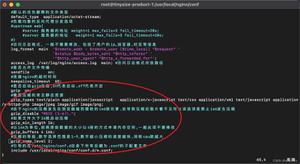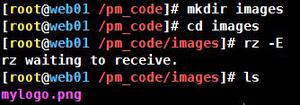nginx启动流程详解

nginx的启动流程主要是从nginx.c文件的main()方法开始的,在这个过程中,nginx会完成诸如解析命令行参数、初始化模块索引、解析配置文件、初始化模块、启动master,worker和cache相关进程等操作。本文主要从main()方法开始,讲解其是如何完成整个流程的。
1. 流程讲解
nginx.c的main()是一个主流程方法,各个子流程都是被封装之后然后被该方法进行调用,从而完成初始化的。如下是main()方法的工作流程:
上面的流程图中,容易忽略的一个流程点在于ngx_preinit_modules()方法,该方法中会对各个模块对象的index属性进行初始化,也即将其index设置为其在所有模块数组中的索引下标。这么做的原因之一在于,nginx在后续保存各个模块的配置对象的时候,也是将其保存于一个数组上的,而其存储的位置是与该配置对应的模块的位置是一致的。通过这种方式,各个模块就可以自定义读取各自模块的配置数据。
在整个初始化过程中,有一个ngx_init_cycle()方法,该方法是解析配置文件,并且初始化各个模块的核心流程。如下是该方法的工作流程:
从上面的流程可以看出,ngx_init_cycle()方法将配置的初始化分为了几个阶段:创建模块配置对象、解析配置文件、初始化模块配置、创建共享内存块、打开监听的端口、初始化各个模块。通过对整个流程的切分,nginx也为各个模块提供了对应的方法,用于对应的模块在相应的切入点实现各自定制化的逻辑。
2. 源码讲解
2.1 nginx.c主流程
对于nginx的启动流程,主要是通过调用额各个子流程所封装的方法来实现的,如下是主流程的源码:
int ngx_cdecl main(int argc, char *const *argv) { ngx_buf_t *b;
ngx_log_t *log;
ngx_uint_t i;
ngx_cycle_t *cycle, init_cycle;
ngx_conf_dump_t *cd;
ngx_core_conf_t *ccf;
ngx_debug_init();
// 该方法的具体作用是初始化一个链表,用于存储系统的error日志
if (ngx_strerror_init() != NGX_OK) {
return 1;
}
// 该方法的主要作用是解析nginx运行时命令行传入的具体参数
if (ngx_get_options(argc, argv) != NGX_OK) {
return 1;
}
// 显示当前nginx的版本信息
if (ngx_show_version) {
ngx_show_version_info();
// 这里指的是如果不进行配置文件的检测,则直接返回,因为进行配置文件的检测需要对配置文件进行解析,
// 因而如果不需要进行解析则直接返回,否则在后续进行配置文件的解析
if (!ngx_test_config) {
return 0;
}
}
/* TODO */ ngx_max_sockets = -1;
// 对nginx缓存的时间信息进行初始化
ngx_time_init();
#if (NGX_PCRE)
// 初始化正则表达式解析所需要的相关函数
ngx_regex_init();
#endif
// 获取当前主进程的id
ngx_pid = ngx_getpid();
// 初始化一个error log的文件句柄
log = ngx_log_init(ngx_prefix);
if (log == NULL) {
return 1;
}
/* STUB */
#if (NGX_OPENSSL)
ngx_ssl_init(log);
#endif
/*
* init_cycle->log is required for signal handlers and
* ngx_process_options()
*/
// 创建一个ngx_cycle_t结构体,这是nginx运行所使用的一个核心结构体,用于在后续存储各种配置信息
ngx_memzero(&init_cycle, sizeof(ngx_cycle_t));
init_cycle.log = log; // 指定所使用的日志
ngx_cycle = &init_cycle; // 将初始化的对象赋值给当前的全局对象
// 初始化一块内存池
init_cycle.pool = ngx_create_pool(1024, log);
if (init_cycle.pool == NULL) {
return 1;
}
// 将执行./nginx命令时传入的参数保存到ngx_cycle_t结构体中
if (ngx_save_argv(&init_cycle, argc, argv) != NGX_OK) {
return 1;
}
// 这里主要是处理nginx的选项值,比如nginx根目录、error log目录和log的日志级别
if (ngx_process_options(&init_cycle) != NGX_OK) {
return 1;
}
// 这里主要是获取系统的一些参数,比如CPU数目、最大socket数目等
if (ngx_os_init(log) != NGX_OK) {
return 1;
}
/*
* ngx_crc32_table_init() requires ngx_cacheline_size set in ngx_os_init()
*/
// 初始化ngx_crc32_table_short的值为ngx_crc32_table16所指定的值
if (ngx_crc32_table_init() != NGX_OK) {
return 1;
}
// 这个方法的主要作用是,获取NGINX环境变量的值,将其按照;或者:进行分割,分割后的每一个元素都是一个socket文件描述符的id,
// 通过这种方式让当前的nginx继承这些文件描述符,然后会或者这些文件描述符的属性信息,并且将其设置到新创建的ngx_listening_t结构体的对应变量中
if (ngx_add_inherited_sockets(&init_cycle) != NGX_OK) {
return 1;
}
// 这里主要是对ngx_modules数组中的每个module的index属性进行赋值,通过这种方式指定当前module在整个模块中所在的位置。
// 另外需要注意的是,在每个模块中都有ctx属性,其为一个多维数组,该属性保存了所有模块的配置信息,而当前模块的配置信息也正好在ctx数组的
// 对应的位置
if (ngx_preinit_modules() != NGX_OK) {
return 1;
}
// 这是初始化nginx各个配置的核心方法
cycle = ngx_init_cycle(&init_cycle);
if (cycle == NULL) {
if (ngx_test_config) {
ngx_log_stderr(0, "configuration file %s test failed",
init_cycle.conf_file.data);
}
return 1;
}
// 如果是测试模式,则打印配置文件的测试结果,并且如果需要dump配置数据,则进行打印
if (ngx_test_config) {
if (!ngx_quiet_mode) {
ngx_log_stderr(0, "configuration file %s test is successful",
cycle->conf_file.data);
}
if (ngx_dump_config) {
cd = cycle->config_dump.elts;
for (i = 0; i < cycle->config_dump.nelts; i++) {
ngx_write_stdout("# configuration file ");
(void) ngx_write_fd(ngx_stdout, cd[i].name.data,
cd[i].name.len);
ngx_write_stdout(":" NGX_LINEFEED);
b = cd[i].buffer;
(void) ngx_write_fd(ngx_stdout, b->pos, b->last - b->pos);
ngx_write_stdout(NGX_LINEFEED);
}
}
return 0;
}
// 这里的ngx_signal主要是记录了启动参数为-s时,其后面的参数值,比如reload、reopen等
if (ngx_signal) {
// 这里主要是根据-s后的参数,对当前的master进程发送相应的系统命令
return ngx_signal_process(cycle, ngx_signal);
}
// 这里主要是读取了系统的一些数据,并且打印了出来,没有实际的作用
ngx_os_status(cycle->log);
ngx_cycle = cycle;
ccf = (ngx_core_conf_t *) ngx_get_conf(cycle->conf_ctx, ngx_core_module);
if (ccf->master && ngx_process == NGX_PROCESS_SINGLE) {
ngx_process = NGX_PROCESS_MASTER;
}
#if !(NGX_WIN32)
// 这里主要是为各个信号设置其处理函数
if (ngx_init_signals(cycle->log) != NGX_OK) {
return 1;
}
if (!ngx_inherited && ccf->daemon) {
// 如果是daemon模式,则新建一个子进程启动
if (ngx_daemon(cycle->log) != NGX_OK) {
return 1;
}
ngx_daemonized = 1;
}
if (ngx_inherited) {
ngx_daemonized = 1;
}
#endif
// 重新写入pid到pid文件中,因为daemon模式会新建一个子进程
if (ngx_create_pidfile(&ccf->pid, cycle->log) != NGX_OK) {
return 1;
}
// 这里主要是将stderr输出指向当前cycle所设置的log文件中
if (ngx_log_redirect_stderr(cycle) != NGX_OK) {
return 1;
}
if (log->file->fd != ngx_stderr) {
if (ngx_close_file(log->file->fd) == NGX_FILE_ERROR) {
ngx_log_error(NGX_LOG_ALERT, cycle->log, ngx_errno,
ngx_close_file_n
" built-in log failed");
}
}
ngx_use_stderr = 0;
if (ngx_process == NGX_PROCESS_SINGLE) {
// 这里是单进程模型,也即事件的处理、缓存的维护等等工作都交由master进程进行,主要用于调试
ngx_single_process_cycle(cycle);
} else {
// 这里是master-worker进程模型,master负责处理客户端的各种指令,
// 并且将相应的指令发送给worker进程进行处理
ngx_master_process_cycle(cycle);
}
return 0;
}
关于最后的master和worker进程的启动流程以及其相互之间的交互方式,我们将在后续的文章中进行讲解。
2.2 ngx_init_cycle()分支流程
ngx_init_cycle()是nginx初始化过程中不可或缺的一部分,其主要对nginx的启动流程进行了切分,从而实现各个模块定制化配置的切入。如下是该方法的源码:
ngx_cycle_t *ngx_init_cycle(ngx_cycle_t *old_cycle) { void *rv;
char **senv;
ngx_uint_t i, n;
ngx_log_t *log;
ngx_time_t *tp;
ngx_conf_t conf;
ngx_pool_t *pool;
ngx_cycle_t *cycle, **old;
ngx_shm_zone_t *shm_zone, *oshm_zone;
ngx_list_part_t *part, *opart;
ngx_open_file_t *file;
ngx_listening_t *ls, *nls;
ngx_core_conf_t *ccf, *old_ccf;
ngx_core_module_t *module;
char hostname[NGX_MAXHOSTNAMELEN];
// 更新当前缓存的时区信息
ngx_timezone_update();
/* force localtime update with a new timezone */
// 获取缓存的时间
tp = ngx_timeofday();
tp->sec = 0;
// 对缓存的时间进行更新
ngx_time_update();
log = old_cycle->log;
// 创建一个内存池
pool = ngx_create_pool(NGX_CYCLE_POOL_SIZE, log);
if (pool == NULL) {
return NULL;
}
pool->log = log;
// 创建一个ngx_cycle_t结构体对象
cycle = ngx_pcalloc(pool, sizeof(ngx_cycle_t));
if (cycle == NULL) {
ngx_destroy_pool(pool);
return NULL;
}
// 设置内存池,日志和旧的cycle对象等属性
cycle->pool = pool;
cycle->log = log;
cycle->old_cycle = old_cycle;
// 设置配置文件的信息
cycle->conf_prefix.len = old_cycle->conf_prefix.len;
cycle->conf_prefix.data = ngx_pstrdup(pool, &old_cycle->conf_prefix);
if (cycle->conf_prefix.data == NULL) {
ngx_destroy_pool(pool);
return NULL;
}
// 设置nginx的路径信息
cycle->prefix.len = old_cycle->prefix.len;
cycle->prefix.data = ngx_pstrdup(pool, &old_cycle->prefix);
if (cycle->prefix.data == NULL) {
ngx_destroy_pool(pool);
return NULL;
}
// 设置配置文件的信息
cycle->conf_file.len = old_cycle->conf_file.len;
cycle->conf_file.data = ngx_pnalloc(pool, old_cycle->conf_file.len + 1);
if (cycle->conf_file.data == NULL) {
ngx_destroy_pool(pool);
return NULL;
}
ngx_cpystrn(cycle->conf_file.data, old_cycle->conf_file.data,
old_cycle->conf_file.len + 1);
cycle->conf_param.len = old_cycle->conf_param.len;
cycle->conf_param.data = ngx_pstrdup(pool, &old_cycle->conf_param);
if (cycle->conf_param.data == NULL) {
ngx_destroy_pool(pool);
return NULL;
}
n = old_cycle->paths.nelts ? old_cycle->paths.nelts : 10;
// 初始化nginx的paths数组
if (ngx_array_init(&cycle->paths, pool, n, sizeof(ngx_path_t *))
!= NGX_OK) {
ngx_destroy_pool(pool);
return NULL;
}
// 初始化cycle->paths.elts数组长度
ngx_memzero(cycle->paths.elts, n * sizeof(ngx_path_t *));
// 初始化用于dump配置文件的ngx_conf_dump_t结构体
if (ngx_array_init(&cycle->config_dump, pool, 1, sizeof(ngx_conf_dump_t))
!= NGX_OK) {
ngx_destroy_pool(pool);
return NULL;
}
// 初始化一个用于dump配置文件的红黑树,其插入操作的方法为ngx_str_rbtree_insert_value
ngx_rbtree_init(&cycle->config_dump_rbtree, &cycle->config_dump_sentinel,
ngx_str_rbtree_insert_value);
// 获取当前打开的文件总数
if (old_cycle->open_files.part.nelts) {
n = old_cycle->open_files.part.nelts;
for (part = old_cycle->open_files.part.next; part; part = part->next) {
n += part->nelts;
}
} else {
n = 20;
}
// 初始化记录打开的文件的链表,默认长度为20
if (ngx_list_init(&cycle->open_files, pool, n, sizeof(ngx_open_file_t))
!= NGX_OK) {
ngx_destroy_pool(pool);
return NULL;
}
// 计算共享内存的个数
if (old_cycle->shared_memory.part.nelts) {
n = old_cycle->shared_memory.part.nelts;
for (part = old_cycle->shared_memory.part.next; part; part = part->next) {
n += part->nelts;
}
} else {
n = 1;
}
// 初始化存储共享内存信息的链表
if (ngx_list_init(&cycle->shared_memory, pool, n, sizeof(ngx_shm_zone_t))
!= NGX_OK) {
ngx_destroy_pool(pool);
return NULL;
}
// 获取监听的socket的数目
n = old_cycle->listening.nelts ? old_cycle->listening.nelts : 10;
// 初始化用于存储监听的socket的数组
if (ngx_array_init(&cycle->listening, pool, n, sizeof(ngx_listening_t))
!= NGX_OK) {
ngx_destroy_pool(pool);
return NULL;
}
// 初始化用于存储监听的socket的数组元素
ngx_memzero(cycle->listening.elts, n * sizeof(ngx_listening_t));
// 初始化用于存储可服用的connection的队列
ngx_queue_init(&cycle->reusable_connections_queue);
// 初始化用于存储各个模块配置信息的对象
cycle->conf_ctx = ngx_pcalloc(pool, ngx_max_module * sizeof(void *));
if (cycle->conf_ctx == NULL) {
ngx_destroy_pool(pool);
return NULL;
}
// 获取当前的hostname
if (gethostname(hostname, NGX_MAXHOSTNAMELEN) == -1) {
ngx_log_error(NGX_LOG_EMERG, log, ngx_errno, "gethostname() failed");
ngx_destroy_pool(pool);
return NULL;
}
/* on Linux gethostname() silently truncates name that does not fit */
hostname[NGX_MAXHOSTNAMELEN - 1] = "";
cycle->hostname.len = ngx_strlen(hostname);
// 申请用于存储hostname的内存空间
cycle->hostname.data = ngx_pnalloc(pool, cycle->hostname.len);
if (cycle->hostname.data == NULL) {
ngx_destroy_pool(pool);
return NULL;
}
// 将获取到的hostname转换为小写,然后存储到cycle->hostname.data中
ngx_strlow(cycle->hostname.data, (u_char *) hostname, cycle->hostname.len);
// 将获ngx_modules数组复制到cycle->modules数组中
if (ngx_cycle_modules(cycle) != NGX_OK) {
ngx_destroy_pool(pool);
return NULL;
}
for (i = 0; cycle->modules[i]; i++) {
// 找到nginx的核心模块
if (cycle->modules[i]->type != NGX_CORE_MODULE) {
continue;
}
module = cycle->modules[i]->ctx;
// 这里主要是初始化各个模块的配置对象的结构体。首先判断各个模块的create_conf()方法是否存在,如果存在,则调用该方法
// 创建对应的conf结构体,然后将其赋值到cycle->conf_ctx的对应索引位置。
// 需要注意的是,这里创建的配置对象结构体的属性值都是默认值,其并没有初始化
if (module->create_conf) {
rv = module->create_conf(cycle);
if (rv == NULL) {
ngx_destroy_pool(pool);
return NULL;
}
cycle->conf_ctx[cycle->modules[i]->index] = rv;
}
}
senv = environ;
// 创建一个用于存储配置信息的结构体,并且初始化各个参数信息
ngx_memzero(&conf, sizeof(ngx_conf_t));
/* STUB: init array ? */
conf.args = ngx_array_create(pool, 10, sizeof(ngx_str_t));
if (conf.args == NULL) {
ngx_destroy_pool(pool);
return NULL;
}
conf.temp_pool = ngx_create_pool(NGX_CYCLE_POOL_SIZE, log);
if (conf.temp_pool == NULL) {
ngx_destroy_pool(pool);
return NULL;
}
conf.ctx = cycle->conf_ctx;
conf.cycle = cycle;
conf.pool = pool;
conf.log = log;
conf.module_type = NGX_CORE_MODULE;
conf.cmd_type = NGX_MAIN_CONF;
#if 0
log->log_level = NGX_LOG_DEBUG_ALL;
#endif
if (ngx_conf_param(&conf) != NGX_CONF_OK) {
environ = senv;
ngx_destroy_cycle_pools(&conf);
return NULL;
}
// 这里主要是对配置文件进行解析
if (ngx_conf_parse(&conf, &cycle->conf_file) != NGX_CONF_OK) {
environ = senv;
ngx_destroy_cycle_pools(&conf);
return NULL;
}
// 如果当前执行的./nginx命令后是-t参数,并且当前不是静态模式,则打印配置文件的解析结果
if (ngx_test_config && !ngx_quiet_mode) {
ngx_log_stderr(0, "the configuration file %s syntax is ok",
cycle->conf_file.data);
}
for (i = 0; cycle->modules[i]; i++) {
if (cycle->modules[i]->type != NGX_CORE_MODULE) {
continue;
}
module = cycle->modules[i]->ctx;
// 这里主要是初始化核心模块的配置信息
// 对于核心模块,目前主要有core、errlog、regex和events这四个,这里的init_conf()方法主要是对这些模块的配置对象中的数据
// 设置默认值,因为定制化的值在前面的配置文件的解析过程中已经进行了设置
if (module->init_conf) {
if (module->init_conf(cycle,
cycle->conf_ctx[cycle->modules[i]->index])
== NGX_CONF_ERROR) {
environ = senv;
ngx_destroy_cycle_pools(&conf);
return NULL;
}
}
}
if (ngx_process == NGX_PROCESS_SIGNALLER) {
return cycle;
}
// 获取ngx_core_module的配置对象
ccf = (ngx_core_conf_t *) ngx_get_conf(cycle->conf_ctx, ngx_core_module);
// 如果是测试模式,则创建对应的pid文件
if (ngx_test_config) {
// 创建存储了pid的文件
if (ngx_create_pidfile(&ccf->pid, log) != NGX_OK) {
goto failed;
}
// 检查如果不是初始化cycle对象,则创建一个pid文件,并且删除旧的pid文件
} else if (!ngx_is_init_cycle(old_cycle)) {
/*
* we do not create the pid file in the first ngx_init_cycle() call
* because we need to write the demonized process pid
*/
old_ccf = (ngx_core_conf_t *) ngx_get_conf(old_cycle->conf_ctx,
ngx_core_module);
if (ccf->pid.len != old_ccf->pid.len
|| ngx_strcmp(ccf->pid.data, old_ccf->pid.data) != 0) {
/* new pid file name */
if (ngx_create_pidfile(&ccf->pid, log) != NGX_OK) {
goto failed;
}
ngx_delete_pidfile(old_cycle);
}
}
// 这里主要是检查lock file是否有操作的权限
if (ngx_test_lockfile(cycle->lock_file.data, log) != NGX_OK) {
goto failed;
}
// 这里主要是检查配置的各个文件路径是否存在,如果不存在就创建该文件夹,并且检查当前用户是否有相应的操作权限,
// 如果权限不够,则提升当前用户的操作权限
if (ngx_create_paths(cycle, ccf->user) != NGX_OK) {
goto failed;
}
// 这里主要是如果没有指定error log文件地址,则打开一个默认的error日志配置文件
if (ngx_log_open_default(cycle) != NGX_OK) {
goto failed;
}
/* open the new files */
part = &cycle->open_files.part;
file = part->elts;
for (i = 0; /* void */ ; i++) {
if (i >= part->nelts) {
if (part->next == NULL) {
break;
}
part = part->next;
file = part->elts;
i = 0;
}
if (file[i].name.len == 0) {
continue;
}
// 打开指定的文件,比如access log等
file[i].fd = ngx_open_file(file[i].name.data,
NGX_FILE_APPEND,
NGX_FILE_CREATE_OR_OPEN,
NGX_FILE_DEFAULT_ACCESS);
ngx_log_debug3(NGX_LOG_DEBUG_CORE, log, 0,
"log: %p %d "%s"",
&file[i], file[i].fd, file[i].name.data);
if (file[i].fd == NGX_INVALID_FILE) {
ngx_log_error(NGX_LOG_EMERG, log, ngx_errno,
ngx_open_file_n
" "%s" failed",
file[i].name.data);
goto failed;
}
#if !(NGX_WIN32)
// 这里主要是为创建的文件设置关闭的监听事件,即当前进程退出时关闭该文件
if (fcntl(file[i].fd, F_SETFD, FD_CLOEXEC) == -1) {
ngx_log_error(NGX_LOG_EMERG, log, ngx_errno,
"fcntl(FD_CLOEXEC) "%s" failed",
file[i].name.data);
goto failed;
}
#endif
}
cycle->log = &cycle->new_log;
pool->log = &cycle->new_log;
/* create shared memory */
part = &cycle->shared_memory.part;
shm_zone = part->elts;
for (i = 0; /* void */ ; i++) {
if (i >= part->nelts) {
if (part->next == NULL) {
break;
}
part = part->next;
shm_zone = part->elts;
i = 0;
}
if (shm_zone[i].shm.size == 0) {
ngx_log_error(NGX_LOG_EMERG, log, 0,
"zero size shared memory zone "%V"",
&shm_zone[i].shm.name);
goto failed;
}
shm_zone[i].shm.log = cycle->log;
opart = &old_cycle->shared_memory.part;
oshm_zone = opart->elts;
for (n = 0; /* void */ ; n++) {
if (n >= opart->nelts) {
if (opart->next == NULL) {
break;
}
opart = opart->next;
oshm_zone = opart->elts;
n = 0;
}
if (shm_zone[i].shm.name.len != oshm_zone[n].shm.name.len) {
continue;
}
if (ngx_strncmp(shm_zone[i].shm.name.data,
oshm_zone[n].shm.name.data,
shm_zone[i].shm.name.len)
!= 0) {
continue;
}
// 这里的三个if判断主要是找到当前的共享内存与旧的cycle中的共享内存名称和大小等完全一致时,直接复用旧的共享内存
if (shm_zone[i].tag == oshm_zone[n].tag
&& shm_zone[i].shm.size == oshm_zone[n].shm.size
&& !shm_zone[i].noreuse) {
shm_zone[i].shm.addr = oshm_zone[n].shm.addr;
#if (NGX_WIN32)
shm_zone[i].shm.handle = oshm_zone[n].shm.handle;
#endif
// 复用之后,对旧的共享内存进行重新初始化
if (shm_zone[i].init(&shm_zone[i], oshm_zone[n].data)
!= NGX_OK) {
goto failed;
}
goto shm_zone_found;
}
// 如果没找到,则释放旧的共享内存
ngx_shm_free(&oshm_zone[n].shm);
break;
}
// 走到这里,说明没有可复用的旧的共享内存,则为当前的共享内存重新申请内存
if (ngx_shm_alloc(&shm_zone[i].shm) != NGX_OK) {
goto failed;
}
// 这里主要是初始化共享内存的内存池信息
if (ngx_init_zone_pool(cycle, &shm_zone[i]) != NGX_OK) {
goto failed;
}
// 初始化新申请的共享内存
if (shm_zone[i].init(&shm_zone[i], NULL) != NGX_OK) {
goto failed;
}
shm_zone_found:
continue;
}
/* handle the listening sockets */
if (old_cycle->listening.nelts) {
ls = old_cycle->listening.elts;
for (i = 0; i < old_cycle->listening.nelts; i++) {
ls[i].remain = 0;
}
nls = cycle->listening.elts;
for (n = 0; n < cycle->listening.nelts; n++) {
for (i = 0; i < old_cycle->listening.nelts; i++) {
if (ls[i].ignore) {
continue;
}
// 前面已经置为了0,因而不会走到if块中
if (ls[i].remain) {
continue;
}
if (ls[i].type != nls[n].type) {
continue;
}
if (ngx_cmp_sockaddr(nls[n].sockaddr, nls[n].socklen,
ls[i].sockaddr, ls[i].socklen, 1)
== NGX_OK) {
// 这里主要是复用旧的监听的文件句柄
nls[n].fd = ls[i].fd;
nls[n].previous = &ls[i];
ls[i].remain = 1;
// 如果新的ngx_listening_s的backlog队列大小不等于旧的backlog队列大小,这将其listen字段设置为1,
// listen字段的含义主要是表征当前句柄正在被监听
if (ls[i].backlog != nls[n].backlog) {
nls[n].listen = 1;
}
// 这里主要是设置新的监听的ngx_listening_s结构体的deferred_accept和accept_filter属性,在TCP数据传输时,
// 如果设置了deferred_accept,那么在进行TCP三次握手之前,只有在真正接收到客户端数据之后,才会将客户端连接从backlog队列移
// 到accept队列中,从而交由NGINX处理,这样可以大大减少nginx的资源消耗
#if (NGX_HAVE_DEFERRED_ACCEPT && defined SO_ACCEPTFILTER)
/*
* FreeBSD, except the most recent versions,
* could not remove accept filter
*/
nls[n].deferred_accept = ls[i].deferred_accept;
if (ls[i].accept_filter && nls[n].accept_filter) {
if (ngx_strcmp(ls[i].accept_filter,
nls[n].accept_filter)
!= 0)
{
nls[n].delete_deferred = 1;
nls[n].add_deferred = 1;
}
} else if (ls[i].accept_filter) {
nls[n].delete_deferred = 1;
} else if (nls[n].accept_filter) {
nls[n].add_deferred = 1;
}
#endif
#if (NGX_HAVE_DEFERRED_ACCEPT && defined TCP_DEFER_ACCEPT)
if (ls[i].deferred_accept && !nls[n].deferred_accept) {
nls[n].delete_deferred = 1;
} else if (ls[i].deferred_accept != nls[n].deferred_accept)
{
nls[n].add_deferred = 1;
}
#endif
// 设置reuseport属性值
#if (NGX_HAVE_REUSEPORT)
if (nls[n].reuseport && !ls[i].reuseport) {
nls[n].add_reuseport = 1;
}
#endif
break;
}
}
if (nls[n].fd == (ngx_socket_t) -1) {
nls[n].open = 1;
#if (NGX_HAVE_DEFERRED_ACCEPT && defined SO_ACCEPTFILTER)
if (nls[n].accept_filter) {
nls[n].add_deferred = 1;
}
#endif
#if (NGX_HAVE_DEFERRED_ACCEPT && defined TCP_DEFER_ACCEPT)
if (nls[n].deferred_accept) {
nls[n].add_deferred = 1;
}
#endif
}
}
} else {
ls = cycle->listening.elts;
for (i = 0; i < cycle->listening.nelts; i++) {
ls[i].open = 1;
#if (NGX_HAVE_DEFERRED_ACCEPT && defined SO_ACCEPTFILTER)
if (ls[i].accept_filter) {
ls[i].add_deferred = 1;
}
#endif
#if (NGX_HAVE_DEFERRED_ACCEPT && defined TCP_DEFER_ACCEPT)
if (ls[i].deferred_accept) {
ls[i].add_deferred = 1;
}
#endif
}
}
// 这里主要是打开各个监听的端口
if (ngx_open_listening_sockets(cycle) != NGX_OK) {
goto failed;
}
if (!ngx_test_config) {
// 这里主要是为各个套接字设置TCP相关的一些属性
ngx_configure_listening_sockets(cycle);
}
/* commit the new cycle configuration */
if (!ngx_use_stderr) {
(void) ngx_log_redirect_stderr(cycle);
}
pool->log = cycle->log;
// 这里调用各个模块的init_module()方法对当前模块进行初始化
if (ngx_init_modules(cycle) != NGX_OK) {
/* fatal */
exit(1);
}
/* close and delete stuff that lefts from an old cycle */
/* free the unnecessary shared memory */
opart = &old_cycle->shared_memory.part;
oshm_zone = opart->elts;
for (i = 0; /* void */ ; i++) {
if (i >= opart->nelts) {
if (opart->next == NULL) {
goto old_shm_zone_done;
}
opart = opart->next;
oshm_zone = opart->elts;
i = 0;
}
part = &cycle->shared_memory.part;
shm_zone = part->elts;
for (n = 0; /* void */ ; n++) {
if (n >= part->nelts) {
if (part->next == NULL) {
break;
}
part = part->next;
shm_zone = part->elts;
n = 0;
}
if (oshm_zone[i].shm.name.len == shm_zone[n].shm.name.len
&& ngx_strncmp(oshm_zone[i].shm.name.data,
shm_zone[n].shm.name.data,
oshm_zone[i].shm.name.len)
== 0) {
goto live_shm_zone;
}
}
// 这里主要是将旧的共享内存释放掉
ngx_shm_free(&oshm_zone[i].shm);
live_shm_zone:
continue;
}
old_shm_zone_done:
/* close the unnecessary listening sockets */
ls = old_cycle->listening.elts;
for (i = 0; i < old_cycle->listening.nelts; i++) {
if (ls[i].remain || ls[i].fd == (ngx_socket_t) -1) {
continue;
}
// 将旧的监听的套接字关闭调
if (ngx_close_socket(ls[i].fd) == -1) {
ngx_log_error(NGX_LOG_EMERG, log, ngx_socket_errno,
ngx_close_socket_n
" listening socket on %V failed",
&ls[i].addr_text);
}
#if (NGX_HAVE_UNIX_DOMAIN)
if (ls[i].sockaddr->sa_family == AF_UNIX) {
u_char *name;
name = ls[i].addr_text.data + sizeof("unix:") - 1;
ngx_log_error(NGX_LOG_WARN, cycle->log, 0,
"deleting socket %s", name);
if (ngx_delete_file(name) == NGX_FILE_ERROR) {
ngx_log_error(NGX_LOG_EMERG, cycle->log, ngx_socket_errno,
ngx_delete_file_n
" %s failed", name);
}
}
#endif
}
/* close the unnecessary open files */
part = &old_cycle->open_files.part;
file = part->elts;
for (i = 0; /* void */ ; i++) {
if (i >= part->nelts) {
if (part->next == NULL) {
break;
}
part = part->next;
file = part->elts;
i = 0;
}
if (file[i].fd == NGX_INVALID_FILE || file[i].fd == ngx_stderr) {
continue;
}
// 将旧的无效的文件路径描述符关掉
if (ngx_close_file(file[i].fd) == NGX_FILE_ERROR) {
ngx_log_error(NGX_LOG_EMERG, log, ngx_errno,
ngx_close_file_n
" "%s" failed",
file[i].name.data);
}
}
// 销毁临时内存池
ngx_destroy_pool(conf.temp_pool);
if (ngx_process == NGX_PROCESS_MASTER || ngx_is_init_cycle(old_cycle)) {
ngx_destroy_pool(old_cycle->pool);
cycle->old_cycle = NULL;
return cycle;
}
if (ngx_temp_pool == NULL) {
ngx_temp_pool = ngx_create_pool(128, cycle->log);
if (ngx_temp_pool == NULL) {
ngx_log_error(NGX_LOG_EMERG, cycle->log, 0,
"could not create ngx_temp_pool");
exit(1);
}
n = 10;
if (ngx_array_init(&ngx_old_cycles, ngx_temp_pool, n,
sizeof(ngx_cycle_t *))
!= NGX_OK) {
exit(1);
}
ngx_memzero(ngx_old_cycles.elts, n * sizeof(ngx_cycle_t *));
// 清理旧的cycle对象,清理方式主要是将其放到事件队列中定时进行清理
ngx_cleaner_event.handler = ngx_clean_old_cycles;
ngx_cleaner_event.log = cycle->log;
ngx_cleaner_event.data = &dumb;
dumb.fd = (ngx_socket_t) -1;
}
ngx_temp_pool->log = cycle->log;
old = ngx_array_push(&ngx_old_cycles);
if (old == NULL) {
exit(1);
}
*old = old_cycle;
if (!ngx_cleaner_event.timer_set) {
ngx_add_timer(&ngx_cleaner_event, 30000);
ngx_cleaner_event.timer_set = 1;
}
return cycle;
failed:
if (!ngx_is_init_cycle(old_cycle)) {
old_ccf = (ngx_core_conf_t *) ngx_get_conf(old_cycle->conf_ctx,
ngx_core_module);
if (old_ccf->environment) {
environ = old_ccf->environment;
}
}
/* rollback the new cycle configuration */
part = &cycle->open_files.part;
file = part->elts;
for (i = 0; /* void */ ; i++) {
if (i >= part->nelts) {
if (part->next == NULL) {
break;
}
part = part->next;
file = part->elts;
i = 0;
}
if (file[i].fd == NGX_INVALID_FILE || file[i].fd == ngx_stderr) {
continue;
}
// 关闭文件路径描述符
if (ngx_close_file(file[i].fd) == NGX_FILE_ERROR) {
ngx_log_error(NGX_LOG_EMERG, log, ngx_errno,
ngx_close_file_n
" "%s" failed",
file[i].name.data);
}
}
if (ngx_test_config) {
ngx_destroy_cycle_pools(&conf);
return NULL;
}
ls = cycle->listening.elts;
for (i = 0; i < cycle->listening.nelts; i++) {
if (ls[i].fd == (ngx_socket_t) -1 || !ls[i].open) {
continue;
}
// 关闭监听的套接字句柄
if (ngx_close_socket(ls[i].fd) == -1) {
ngx_log_error(NGX_LOG_EMERG, log, ngx_socket_errno,
ngx_close_socket_n
" %V failed",
&ls[i].addr_text);
}
}
ngx_destroy_cycle_pools(&conf);
return NULL;
}
3. 小结
本文首先对nginx的主流程和ngx_init_cycle()配置流程的工作原理进行了讲解,然后从源码层面对这两个流程进行了深入分析。
以上是 nginx启动流程详解 的全部内容, 来源链接: utcz.com/z/511426.html









